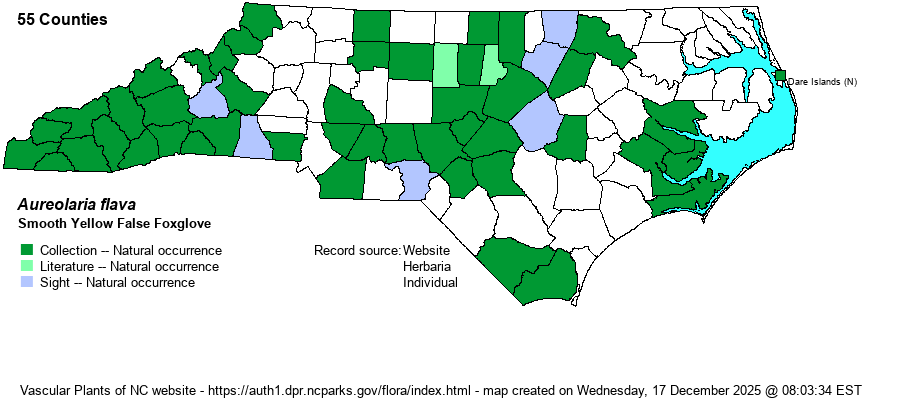| Section 6 » Order Scrophulariales » Family Orobanchaceae |
Show/Hide Synonym
| taxonName | relationship | relatedTaxonName | relatedTaxonRefText | relComments |
|---|
|
|
|
|
|
| Aureolaria flava | >< | Aureolaria flava var. flava | Gleason and Cronquist (1991) | | | Aureolaria flava | >< | Aureolaria flava var. flava | Gleason (1952) | | | Aureolaria flava | >< | Aureolaria flava var. flava | | | | Aureolaria flava | >< | Aureolaria flava var. flava | | | | Aureolaria flava | >< | Aureolaria flava var. flava | | | | Aureolaria flava | > | Aureolaria flava var. macrantha | Gleason and Cronquist (1991) | | | Aureolaria flava | > | Aureolaria flava var. macrantha | Gleason (1952) | | | Aureolaria flava | > | Aureolaria flava var. macrantha | | | | Aureolaria flava | > | Aureolaria flava var. macrantha | | | | Aureolaria flava | > | Aureolaria flava var. macrantha | | | | Aureolaria flava | > | Gerardia flava var. flava | Fernald (1950) | | | Aureolaria flava | > | Gerardia flava var. reticulata | Fernald (1950) | | | Aureolaria flava | < | Aureolaria flava | Flora of North America (1993b, 1997, 2000, 2002a, 2002b, 2003a, 2004b, 2005, 2006a, 2006b, 2006c, 2007a, 2009, 2010) | | | Aureolaria flava | < | Aureolaria flava | | | | Aureolaria flava | > | Aureolaria flava ssp. typica | Pennell (1935)=P. | | | Aureolaria flava | >< | Aureolaria flava ssp. flava | Small (1933, 1938) | | | Aureolaria flava | > | Aureolaria flava ssp. reticulata flava var. macrant | Fernald (1950) | | | Aureolaria flava | > | Aureolaria flava ssp. reticulata flava var. macrant | | | | Aureolaria flava | > | Aureolaria flava ssp. macrantha | Pennell (1935)=P. | | | Aureolaria flava | > | Aureolaria flava ssp. flava | Small (1933, 1938) | | | Source: Weakley's Flora |
|
| Author | (L.) Farwell | |
| Distribution | Throughout the Mountains; scattered over most of the Piedmont, though scarce in some areas; very widely scattered in the Coastal Plain, with many gaps in the range. Thus, broadly statewide in overall range. For what it's worth -- the great majority of photos on iNaturalist are of other Aureolaria species and rightfully have not been vetted; perhaps the program's suggested species needs refining.
This is a wide-ranging Eastern species, occurring from ME and WI south to central FL and eastern TX.
| |
| Abundance | Fairly common in the Mountains, but only infrequent to locally fairly common in most of the Piedmont, being quite scarce in the western counties (for some unknown reason). Rare to locally uncommon in the Coastal Plain, and seemingly absent in many areas, especially the northeastern corner of the state. | |
| Habitat | This is a species of a wide array of deciduous forests, and being a root parasite on oaks, it is found in close association with members of that genus (Quercus). It favors thin, rocky ground, such as along rocky streamsides, in rocky woods, on dry ridges, and other thin and often rocky places within a hardwood or mixed forest. Considering its wide range of potential places where it could occur, it often requires some effort to find it. | |
| Phenology | Blooms in August and September, and fruits from September to October. | |
| Identification | This is the tallest of the five species of Aureolaria in NC, so tall that it usually is seen leaning, rarely growing straight and erect, with essentially no branches. Its stem can reach 4-5 feet long, rarely 6 feet long. It has numerous paired/opposite leaves, those on the lower stem quite different from those of the upper. The lower leaves are deeply cut or divided (with the sinus nearly reaching the midrib) into about 7-9 narrow lobes, quite fern-like, about 4 inches long and 2 inches wide, with a tapering tip. The upper leaves, however, are usually just narrowly elliptical and entire, about 2 inches long and much narrower. The inflorescence is like several others in the genus, being a terminal "raceme" of single flowers in upper leaf axils, each flower being bell-like and about 1.5 inches long and 1-inch across, bright or deep yellow. All of the Aureolaria species have such large and bright yellow flowers, but this species can be separated by the other two wand-like members of the genus -- A. virginica and A. levigata -- by its deeply cut, fern-like lower stem leaves that are somewhat triangular in overall shape; A. virginica has it leaves with rounded lobes on the leaves, like a White Oak (Q. alba), but not deeply cut, whereas A. levigata generally has only entire leaves. Though widely occurring in the state, your best bet to see it is in the southern mountains. | |
| Taxonomic Comments | Many references split up the species into subspecies or varieties. Weakley (2018) does not.
| |
| Other Common Name(s) | Smooth Oak-leech | |
| State Rank | S3 [S4] | |
| Global Rank | G5 | |
| State Status | | |
| US Status | | |
| USACE-agcp | | |
| USACE-emp | | |

